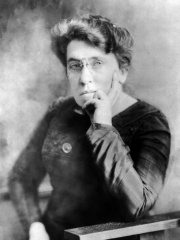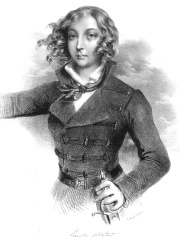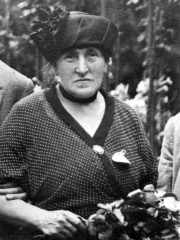



The Most Famous
SOCIAL ACTIVISTS from Lithuania
This page contains a list of the greatest Lithuanian Social Activists. The pantheon dataset contains 840 Social Activists, 5 of which were born in Lithuania. This makes Lithuania the birth place of the 35th most number of Social Activists behind Syria, and Netherlands.
Top 5
The following people are considered by Pantheon to be the most legendary Lithuanian Social Activists of all time. This list of famous Lithuanian Social Activists is sorted by HPI (Historical Popularity Index), a metric that aggregates information on a biography's online popularity.

1. Emma Goldman (1869 - 1940)
With an HPI of 73.94, Emma Goldman is the most famous Lithuanian Social Activist. Her biography has been translated into 95 different languages on wikipedia.
Emma Goldman (June 27, 1869 – May 14, 1940) was a Russian-born anarchist revolutionary, political activist, and writer. She played a pivotal role in the development of anarchist political philosophy in North America and Europe in the first half of the 20th century. Born in Kaunas, Lithuania (then within the Russian Empire), to a Lithuanian Jewish family, Goldman immigrated to the United States in 1885. Attracted to anarchism after the Haymarket affair in Chicago, Goldman became a writer and a renowned lecturer on anarchist philosophy, women's rights, and social issues, attracting crowds of thousands. She and anarchist writer Alexander Berkman, her lover and lifelong friend, planned to assassinate industrialist and financier Henry Clay Frick as an act of propaganda of the deed. Frick survived the attempt on his life in 1892, and Berkman was sentenced to 22 years in prison. Goldman was imprisoned several times in the years that followed, for "inciting to riot" and illegally distributing information about birth control. In 1906, Goldman founded the anarchist journal Mother Earth. In 1917, Goldman and Berkman were sentenced to two years in jail for conspiring to "induce persons not to register" for the newly instated draft. After their release from prison, they were arrested—along with 248 others—in the so-called Palmer Raids during the First Red Scare and deported to Russia in December 1919. Initially supportive of that country's October Revolution that brought the Bolsheviks to power, Goldman changed her opinion in the wake of the Kronstadt rebellion; she denounced the Soviet Union for its violent repression of independent voices. She left the Soviet Union and in 1923 published a book about her experiences, My Disillusionment in Russia. While living in England, Canada, and France, she wrote an autobiography called Living My Life. It was published in two volumes, in 1931 and 1935. After the outbreak of the Spanish Civil War, Goldman traveled to Spain to support the anarchist revolution there. She died in Toronto, Ontario, Canada, in 1940, aged 70. During her life, Goldman was lionized as a freethinking "rebel woman" by admirers, and denounced by detractors as an advocate of politically motivated murder and violent revolution. Her writing and lectures spanned a wide variety of issues, including prisons, atheism, freedom of speech, militarism, capitalism, marriage, free love, and homosexuality. Although she distanced herself from first-wave feminism and its efforts toward women's suffrage, she developed new ways of incorporating gender politics into anarchism. After decades of obscurity, Goldman gained iconic status in the 1970s by a revival of interest in her life, when feminist and anarchist scholars rekindled popular interest.

2. Emilia Plater (1806 - 1831)
With an HPI of 71.60, Emilia Plater is the 2nd most famous Lithuanian Social Activist. Her biography has been translated into 62 different languages.
Countess Emilia Broel-Plater (Lithuanian: Emilija Pliaterytė; 13 November 1806 – 23 December 1831) was a Polish–Lithuanian noblewoman and revolutionary from the lands of the partitioned Polish–Lithuanian Commonwealth. Raised in a patriotic tradition in Līksna near Daugavpils, she fought in the November Uprising of 1830–1831 against the Russian Empire. She raised a small unit, participated in several engagements in present-day Lithuania, and received the rank of captain in the Polish insurgent forces. When the main forces under the General Dezydery Chłapowski decided to cease fighting and cross into Prussia, Plater vowed to continue the fight and wanted to cross into Poland where the uprising was still ongoing. However, she fell ill and died. She was a leader in an uprising and her story became widely publicized and inspired a number of works of art and literature. A maiden warrior, she is a national heroine in Poland, Lithuania and Belarus. She has been venerated by Polish artists and by the nation at large as a symbol of women fighting for the national cause. She has been referred to as the Lithuanian or Polish Joan of Arc.

3. Klara Zamenhof (1863 - 1924)
With an HPI of 60.52, Klara Zamenhof is the 3rd most famous Lithuanian Social Activist. Her biography has been translated into 25 different languages.
Klara Zamenhof (née Silbernik; 6 October 1863 – 6 December 1924) was a Polish Esperantist. She was married to L. L. Zamenhof, the inventor of the Esperanto language.

4. Romas Kalanta (1953 - 1972)
With an HPI of 58.17, Romas Kalanta is the 4th most famous Lithuanian Social Activist. His biography has been translated into 25 different languages.
Romas Kalanta (22 February 1953 – 14 May 1972) was a 19-year-old Lithuanian high school student who killed himself by self-immolation in an act of protest against the Soviet regime in Lithuania. His death provoked the largest post-war riots in Lithuania and inspired similar self-immolations. In 1972, 13 more people committed suicide by self-immolation in Lithuania. Kalanta became a symbol of the Lithuanian resistance throughout the 1970s and 1980s. In 2000, he was posthumously awarded the Order of the Cross of Vytis.

5. Iosif Grigulevich (1913 - 1988)
With an HPI of 57.17, Iosif Grigulevich is the 5th most famous Lithuanian Social Activist. His biography has been translated into 15 different languages.
Iosif Romualdovich Grigulevich (Russian: Иосиф Ромуальдович Григулевич; Lithuanian: Josifas Romualdovičius Grigulevičius; May 5, 1913 – June 2, 1988) was a Soviet secret police (NKVD) operative active between 1937 and 1953, when he played a role in assassination plots against Communist and Bolshevik individuals who were not loyal to Joseph Stalin. This included the murders of claimed and actual Trotskyists during the Spanish Civil War, most notably Andreu Nin, and an initial, unsuccessful assassination attempt against Leon Trotsky in Mexico City. Under an assumed identity as Teodoro B. Castro, a wealthy Costa Rican expatriate living in Rome, Grigulevich served as the ambassador of the Republic of Costa Rica to both Italy and Yugoslavia (1952–1954). He was tasked by the NKVD with the assassination of Yugoslav leader Josip Broz Tito, but the mission was aborted following Stalin's death in 1953. Recalled to Moscow, Grigulevich retired from his career as a spy (the details of which would remain secret until after his death) and established himself as a professional historian. He was employed as a research fellow at the Institute of Ethnography of the Soviet Academy of Sciences and published many books and articles on the history of Latin America and on the modern Roman Catholic Church. In 1979 he was elected as a corresponding member of the Academy of Sciences. Writing under the pen-name I. Lavretsky (after his mother's maiden name) he published several bestselling biographies of Latin American revolutionaries, including Che Guevara.
People
Pantheon has 5 people classified as Lithuanian social activists born between 1806 and 1953. Of these 5, none of them are still alive today. The most famous deceased Lithuanian social activists include Emma Goldman, Emilia Plater, and Klara Zamenhof.
Deceased Lithuanian Social Activists
Go to all RankingsEmma Goldman
1869 - 1940
HPI: 73.94
Emilia Plater
1806 - 1831
HPI: 71.60
Klara Zamenhof
1863 - 1924
HPI: 60.52
Romas Kalanta
1953 - 1972
HPI: 58.17
Iosif Grigulevich
1913 - 1988
HPI: 57.17
Overlapping Lives
Which Social Activists were alive at the same time? This visualization shows the lifespans of the 5 most globally memorable Social Activists since 1700.

